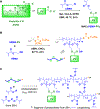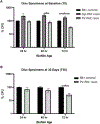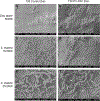Synthesis and antibacterial activity of polymer-antibiotic conjugates incorporated into a resin-based dental adhesive
- PMID: 33464241
- PMCID: PMC7990707
- DOI: 10.1039/d0bm01910k
Synthesis and antibacterial activity of polymer-antibiotic conjugates incorporated into a resin-based dental adhesive
Abstract
This work reports on polymer-antibiotic conjugates (PACs) as additives to resin-based restorative dental materials as a new strategy to convey sustained antibacterial character to these materials. Such antibacterial performance is expected to improve their longevity in the oral cavity. Using the previously reported ciprofloxacin (Cip)-based PAC as a control, a penicillin V (PV)-based PAC was investigated. The monomer-antibiotic conjugate (MAC) containing a methacrylate monomer group and a PV moiety was prepared via nucleophilic substitution between 2-chloroethyl methacrylate (CEMA) and penicillin V potassium (PVK). The PV-based PAC was synthesized by reversible addition-fragmentation chain transfer (RAFT) polymerization of the MAC with hydroxyethyl methacrylate (HEMA), and further characterized by 1H NMR and gel permeation chromatography (GPC) analysis. Antibiotic resistance was investigated by passaging bacteria in low concentrations of the antibiotic for 19 days, followed by a 48 h challenge at higher concentrations. Our results suggest that the development of antibiotic resistance is unlikely. Zone of inhibition (ZOI) assays revealed no clearing zones around PV-containing resins indicating minimal antibiotic leakage from the material. Similarly, MTT assay demonstrated that the antibiotic-containing specimens did not release cytotoxic byproducts that may inhibit human gingival fibroblast growth. Counting of colony-forming units in an S. mutans biofilm model was used to assess bacterial survival at baseline and after subjecting the antibiotic-containing resin specimens to an enzymatic challenge for 30 days. Significantly reduced bacterial counts were observed as the biofilm aged from 24 to 72 h, and salivary enzymatic exposure did not reduce the antibacterial efficacy of the discs, suggesting that PV-resin will be effective in reducing the re-incidence of dental caries.
Conflict of interest statement
Conflicts of Interest
There are no conflicts to declare.
Figures










Similar articles
-
Mechanical characterization and adhesive properties of a dental adhesive modified with a polymer antibiotic conjugate.J Mech Behav Biomed Mater. 2022 May;129:105153. doi: 10.1016/j.jmbbm.2022.105153. Epub 2022 Mar 2. J Mech Behav Biomed Mater. 2022. PMID: 35272151 Free PMC article.
-
Polymer-antibiotic conjugates as antibacterial additives in dental resins.Biomater Sci. 2018 Dec 18;7(1):287-295. doi: 10.1039/c8bm01228h. Biomater Sci. 2018. PMID: 30468214
-
Influence of zinc oxide quantum dots in the antibacterial activity and cytotoxicity of an experimental adhesive resin.J Dent. 2018 Jun;73:57-60. doi: 10.1016/j.jdent.2018.04.003. Epub 2018 Apr 10. J Dent. 2018. PMID: 29653139
-
How we are assessing the developing antibacterial resin-based dental materials? A scoping review.J Dent. 2020 Aug;99:103369. doi: 10.1016/j.jdent.2020.103369. Epub 2020 May 7. J Dent. 2020. PMID: 32387506
-
The role of adhesive materials and oral biofilm in the failure of adhesive resin restorations.Am J Dent. 2017 Oct;30(5):285-292. Am J Dent. 2017. PMID: 29178733 Review.
Cited by
-
Mechanical characterization and adhesive properties of a dental adhesive modified with a polymer antibiotic conjugate.J Mech Behav Biomed Mater. 2022 May;129:105153. doi: 10.1016/j.jmbbm.2022.105153. Epub 2022 Mar 2. J Mech Behav Biomed Mater. 2022. PMID: 35272151 Free PMC article.
-
Infection-responsive long-term antibacterial bone plates for open fracture therapy.Bioact Mater. 2023 Jan 14;25:1-12. doi: 10.1016/j.bioactmat.2023.01.002. eCollection 2023 Jul. Bioact Mater. 2023. PMID: 36713134 Free PMC article.
References
-
- Xiong M, Han Z, Song Z, Yu J, Ying H, Yin L and Cheng J, Angew. Chem. Int. Ed, 2017, 56, 10826–10829. - PubMed
-
- Zhong X, Tong C, Liu T, Li L, Liu X, Yang Y, Liu R and Liu B, Biomater. Sci, 2020, 8, 6670–6682. - PubMed
-
- Borjihan Q and Dong A, Biomater. Sci, 2020, 8, 6867–6882. - PubMed
-
- Leong J, Yang C, Tan J, Tan BQ, Hor S, Hedrick JL and Yang YY, Biomater. Sci, 2020, 8, 6920–6929. - PubMed
MeSH terms
Substances
Grants and funding
LinkOut - more resources
Full Text Sources
Other Literature Sources
Medical
Molecular Biology Databases

